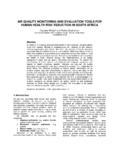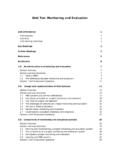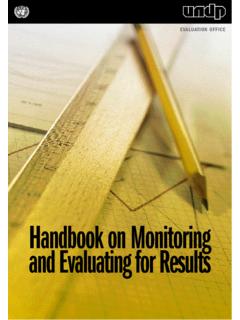Transcription of Effective Monitoring Evaluation - Hampshire
1 Effective Monitoring & Evaluation Monitoring & Evaluation Evaluation Monitoring and Evaluation should be built into g the project at the planning stage. It should not pp , be an add on' that happens at the end, but should be woven throughout the project. Evaluation is a way of seeing, of reflecting on practice (Van Der Eyken 1993). (Van Der Eyken 1993). Judging merit against some yardstick . (Phillips et al, 1994). Monitoring & Evaluation Do you know? Do you know? How you can show that a project is worth continuing p j p p What the project has done for the people living in your community Why grant providers should continue to fund Why grant providers should continue to fund your project This is what Evaluation and Monitoring can h l help you find out and give you evidence to fi d t d i id t back up your findings Monitoring & Evaluation What is Self Evaluation What is Self Evaluation Self Evaluation is carried out by the Self Evaluation is carried out by the organisation that is delivering a project.
2 Th The Evaluation is internally devised and l i i i ll d i d d delivered. delivered Monitoring & Evaluation Self Evaluation Self Evaluation .. is usually seen as inextricably linked with i ll i i bl li k d i h organisational development. Evaluation thus becomes an integral part of an organisation working out what it is trying to achieve, collecting evidence of progress, reflecting on how it is doing, and exploring the implications for future planning and development (Charitable Evaluation Services, 1998). (Charitable Evaluation Services, 1998). Monitoring & Evaluation Self Evaluation Advantages Self Evaluation . The Evaluation is more integrated with other organisational processes p g Can tap into internal knowledge more readily y Is flexible to the needs of the organisation Control of Evaluation & other data remains internal Control of Evaluation & other data remains internal The results are more likely to lead to change The process is less threatening to staff & volunteers Usually cheaper Enables staff and volunteers to learn new skills Monitoring & Evaluation Self Evaluation challenges Self Evaluation .
3 D. Demands time and resources from the organisation d ti d f th i ti May be viewed as less objective Internal staff may be too close to the project creating conflicts of interest Participants may talk less freely to internal staff Staff & volunteers may not have the necessary Evaluation skills May be difficult to link Evaluation findings to broader issues Monitoring & Evaluation Project & Evaluation Diagram What problem do you want to work with? Needs Assessment Funding Partnership What changes do What must you you want to achieve do to achieve What must you this change? in yyour community? y do differently to Outcomes Aims & Objectives increase your success?
4 Programme development How will you know when Have yyou succeeded thi change this h h has occurred? d? in producing the Performance indicators, outcomes, required change? quality standards Evaluation of organisation &. project Monitoring & Evaluation The benefits of Evaluation For Funders For Organisations Ensures good use of public funds Ensures that resources are used efficiently Highlights good practice Helps clarify aims & objectives Identifies gaps in provision Provides evidence of impact Provides a basis for selecting among competing Sets standards and provides quality control applicants Uncovers unexpected consequences Informs policy Provides information for planning and campaigning Helps validate new approaches For Staff F Users For U.
5 Provides feedback on performance Demonstrates usefulness or limitations of Challenges assumptions and confirms project impressions Provides an overview of the project Suggests areas to develop further Offers a chance to have views heard Offers access to the views of others Represents an opportunity for more active Helps Helps staff (& volunteers) to see their participation work in a wider context Publicises any gaps Monitoring & Evaluation Starting Point Starting Point To be able to carry out Effective Monitoring and y g Evaluation you need to have something to measure against When you are planning a project you need to set some aims and objectives Monitoring & Evaluation Setting Aims & Objectives Setting Aims & Objectives Aims These are general statements of intent, p p used to indicate the overall purpose of a project or programme.
6 For more help see the Project Planning module support service/how to . d /. do/project l h Monitoring & Evaluation Setting Aims & Objectives Setting Aims & Objectives Objectives These state what will be achieved at specific points and are h h ill b hi d ifi i d more down to earth action statements. They provide structure for an event or project They act as stepping stones what skills, knowledge or behaviour are you hoping to change as a result of the project They help with planning They help with planning Ensure you use appropriate verbs, avoid word like understand' unless you can prove it in your Evaluation Need to be Need to be measurable'as measurable as they will act as a basis for they will act as a basis for appropriate Monitoring and Evaluation Need to be SMART (see next slide).
7 Monitoring & Evaluation Setting Aims & Objectives Setting Aims & Objectives S = Specific M = Measurable A = Attainable/ Achievable A = Attainable/ Achievable R = Realistic T = Have a timetable Monitoring & Evaluation What sort of data? Quantitative or Qualitative Quantitative Numerical or statistical data Numerical or statistical data the number of attendees This type of information Gives objective, accurate results Gives objective accurate results Can be used to make comparisons Does not identify opinions/ feelings Does not identify opinions/ feelings Unlikely to measure impact' (long term changes). Monitoring & Evaluation Quantitative or Qualitative Quantitative or Qualitative Qualitative Observations that do not involve measurements or numbers descriptions or opinions This type of information Can produce more in depth, comprehensive information Can produce more in depth comprehensive information Collects opinions that have a holistic view Can have problems with reliability if not managed well I.
8 Is subject to researcher bias bj t t h bi Can be time consuming Can't be generalised to the wider community Can give an indication of any changes the project has made (impacts). Can measure soft outcomes' that can not be measured in numbers Monitoring & Evaluation Summative or Formative Summative or Formative Summative gather the information towards p j the end of the project FFormative . i G h i i f Gathering information right from i i h f the beginning of the planning stage, Focuses on the process as well as the output, probably the most useful for you. the most useful for you. Monitoring & Evaluation When do you think about When do yyou think about Monitoring and Evaluation ?
9 Monitoring and Evaluation Should feature in the first plans for any project . not an add on at the end not an add on at the end Should ensure you have the time and resources needed to implement (you can add this cost needed to implement (you can add this cost to a funding application). Monitoring & Evaluation Guidance Make it participative Make sure you are gathering the information you need Make sure you are gathering the information you need if you don't need it why ask! Don Don'tt leave it to the last minute leave it to the last minute Plan it and include the costs into your project Ensure all staff & volunteers are informed and involved Make it fun & interesting Monitoring & Evaluation Methods Observations A lid A valid method gathering information, have a think about how this is recorded h d h i i f i h hi k b h hi i d d and evaluated.)
10 Photography can be used as one tool for this. Questionnaires Q i i Tried and trusted method, remember to make them user friendly consider equalities and diversity with this method, will everyone be able to contribute equally through this method equally through this method. Interviews G d Good way to collect qualitative information, but 1:2:1 method will be time ll li i i f i b 121 h d ill b i consuming. Also need to ensure interviewers are well trained to reduce interviewer bias. Telephone interviews As above but an opportunity to speak to people after they have had a chance to reflect on the event or activity reflect on the event or activity.










